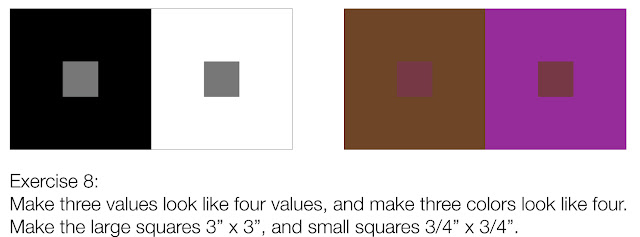Project Description
In
gouache, create a value scale in 11 steps total starting with white
(from the tube) and ending with black (from the tube). For the value scale, you will need 11
tiles total. Each tile will be painted a different value from black to
white. The value must shift evenly between tiles. 100%, 90%, 80%, 70%,
60%, 50%, 40%, etc. Use the provided color wheel I gave you for
reference.
Part One- Painting Tiles for Tessellating Value Scale. Due February 22.
1. Draw your pattern/tiles
Lay out your pattern on bristol board, leaving a ½" gap between each tile. The gap will give you space to paint beyond the lines and will make it easier to cut your tiles in the next step.
Take
advantage of drawing triangles and a straight edge if you will be
making tiles based in triangles, such as rhombus, equilateral triangle,
hexagon. All of these are based in the equilateral triangle and can be
drawn simply with a 30/60/90 drafting triangle.
If
you are able, you may draw your pattern in illustrator and have it
printed on the bristol. You will have to check with the print lab to see
they are wiling to do this. See example of layout below:
 |
| Lines drawn at 90 degree angles with ½" spacing |
3. Paint your tiles
You
will need more than 100 tiles to get the 11 for your value scale. This
is because not all of them will be acceptable in terms of correct value,
or painting technique. Remember, your goal is to make these tiles look
like they were painted in a factory (no brush strokes, no streaking).
When
painting your tiles, be sure to watch some videos on how to
mix gouache. When I gave the demo in class, I told you to watch out for a
few things. I have listed them here:
- Don't waste paint- Start with white, add black.
- Use a wash brush (¾" or 1")
- Mix paints on a white surface (you may use a large ceramic dinner plate, plastic disposable plate, or disposable palette.
- Have two cups of water for cleaning your brushes. Keep them clean.
- Minimize Streaking- Clean brush thoroughly between painting different values.
- Minimize Streaking- Mix paints thoroughly on palette- adding small amounts of black to the white.
- Minimize dry brush or water color effect- Maintain proper consistency of paint (not too much water, or too dry)
- Minimize Streaks- Load brush evenly (both sides of bristles).
- Minimize Brush strokes- Lay paint down evenly (not too thick or thin). Paint in only one direction.
- Don't stack paint tiles while drying.
Here's a person that documented a similar project and posted her process.
Your's will be the same with the exception that you may choose
a different shape for your tiles. This is the tessellation part of our
project. She did her's with squares.
The painted tiles are due Wed, Feb 22nd. You will need to bring all 100+ tiles to class, uncut.
Part Two- Assemble Tessellating Value Scale. Due Monday, Feb 27th
Here
is the layout for the value scale. Please use the black mat board
provided in class. Your mat board will be cut to 5 inches x 15 inches.
Process
1. Cut swatches in long 1" wide strips
2. Compare the swatches to the value scale I gave you.
3. Mark the closest value (ex. 30%, 40%) on the back of the swatch.
4. Cut the swatches from the 1" wide strips. Be sure to leave extra room beyond 1".
5. Choose the best swatches to accurately represent the 11 steps in value.
6. Lay them out and double check (before gluing)
7. Draw two parallel lines 1" apart on a clean sheet of bristol board.
8. Glue the bristol board and the back of your swatches.
9. Carefully attach the swatches to your pre-glued bristol board.
10. Cut the newly glued 11" tall value scale down to 1" width.
11. Using pencil, lightly mark your mat board where the value scale will go.
12. Glue the mat board.
13. Glue the back of the value scale.
14. Attach the value scale to the mat board using a ruler as a guide.
15. Clean ALL excess rubber cement from mat board and value scale.
16. Write name on back.






















